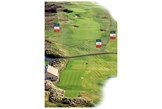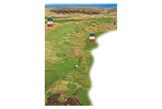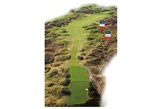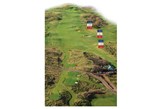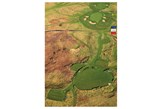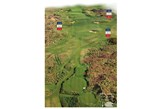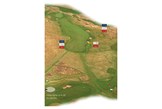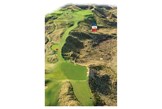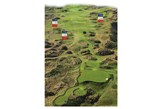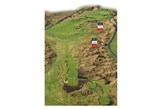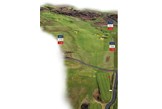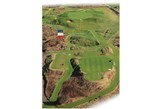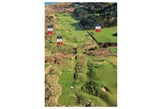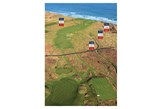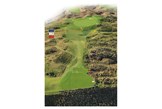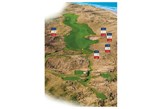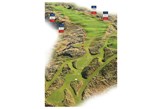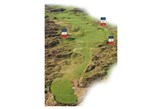Graeme McDowell’s guide to Portrush
Published: Last updated:
Royal Portrush: Your guide by local Graeme McDowell
Few know Royal Portrush better than Graeme McDowell. He grew up playing the course, his brother works there as a greenkeeper and most of his family still live in the town.
“Having grown up in the town and lived there for most of my life, it would be one of my proudest moments to play The Open there,” he admits. “Growing up as a young boy, the Claret Jug was always very synonymous with Portrush, but I don’t think I ever, in my wildest dreams, pictured going back there to play an Open Championship.
Despite basing himself in America now, he still takes time out from the PGA Tour to visit his home town whenever he can and often that includes a round on the newly- designed course.
“The R&A has done a fantastic job in capturing the flavour of Portrush with some of the new green complexes and changes,” he told us. “The two new holes capture a beautiful piece of land off the Valley course, which was probably my favourite corner and used to be the old 5th and 6th. They’ve really captured Harry Colt’s original architecture. I’m sure the players will love it.”
With that in mind, we got in early and persuaded GMac to give us his guide to the course. You can also find out what Rory thinks about the new 7th and 8th holes.
Hole 1: Hughies
• Par 4 | 421 yards
• The fairway is framed by thick rough and out of bounds down both sides.
• The green gathers from the right and sits above a deep bunker on the left.
• The false front means it’s easy to putt off the green from the top tier.
GMAC Says: An intimidating tee shot, with out of bounds left and right. The typical play is to lay- up short of the bunker on the left-hand side. That will leave a medium-to- long approach shot uphill to a two-tier green, guarded by some very deep bunkers. The miss is to the right, but anything short could catch the false front.

Hole 2: Giant’s Grave
• Par 5 | 574 yds
• Catching the slope after the first set of bunkers can shorten the hole by 30 yards.
• The green has been pushed back by 50 yards from where it was previously.
• Balls pitching before the green can kick towards the bunkers on the right.
GMAC Says: A de nite birdie opportunity. Off the tee, you’ve got to negotiate four bunkers with out of bounds right and thick rough on the left. When going for it in two, the line is straight over the cross bunkers 60 yards short of the green. If you want to lay- up, the play is just short of the bunkers, and into a little bowl.

Hole 3: Islay
• Par 3, 177 yards
• The tee box is one of the highest points on the course.
• Every putt tends to break from the right.
• The sensible play is to aim for the centre of the green all week.
GMAC Says: An aesthetically beautiful hole, with the green perched in a little bowl. Depending on wind, it’s a potential birdie opportunity. There is a small dune front-left and front-right, where they like to tuck the pins behind. Anything long will catch a severe drop off at the back.
Hole 4: Fred Daly’s
• Par 4 | 482 yards
• Named after Fred daly, who won The Open in 1947.
• Out of bounds runs down the entire right side.
• A back-left pin position can be partially hidden by the mounds.
GMAC Says: Stroke index one on the scorecard, and the first real look at Portrush’s teeth. There’s a bunker left off the tee, which is about 300 yards to y. If you don’t take it on, the landing area squeezes you down the right half and up against the out of bounds, leaving a long iron in. The green is well- protected, and sits below some high dunes which is a characteristic of Portrush.
Hole 5: White Rocks
• Par 4 | 374 yards
• This hole could play as short as 350 yards if the R&A pushes the tees up.
• With wind behind, the big hitters could reach with a three-wood.
• To drive the green, tee shot needs to be threaded between two new bunkers.
GMAC Says: The back tee is no longer in play, so there’s a great chance to blow it up by the green. Missing it on the right is particularly bad because it leaves a terrible angle to a severe, two-tiered green with a large hollow just in front. There’s out of bounds at the back, so it’s a real risk and reward.

Hole 6: Harry Colt’s
• Par 3 | 194 yards
• The tee is perched above the ocean, which means the wind can play havoc.
• One of only two par-3s without any bunkers.
• The green slopes from back to front
GMAC Says: The tee box sits right by the beach, and plays back into the breeze. The front half of the green is easily accessible, but there is a false front so anything short will roll off. A pin on the back tier will be hard to get at as it brings two large hollows into play.

Hole 7: Curran Point
• Par 5 | 592 yards
• The first of the two new holes, designed by Martin Ebert.
• A drive of nearly 300 yards is needed to clear the new Big Nellie.
• The fairway reduces in size the closer you get to the green.
GMAC Says: A great two- or three-shotter. The main feature is the cavernous bunker on the right. How aggressive you are with the tee shot will determine whether you can take on the green. The approach plays uphill to a plateau, with lots of humps and hollows and a big run-off on the left.
RORY Says: Visually, it’s quite an intimidating tee shot. you’ve got Big Nellie on the right; another bunker on the left. The bigger hitters will be able to carry the first bunker on the right, but the second bunker on the left is going to be in play. For a long hole with a driver in the hand, it’s actually quite a narrow landing area. The way the hole shapes up, you probably want to aim it up the left side and cut it up there. If you get a good tee shot away, you are going to have a chance to go for this green in two. Most of the green feeds into the middle, but you have to get it on line. If you go off line at all, it repels the ball away from the green. The drop off on the left side is quite severe. There are a lot of good options for hole locations, but it should be a chance for most of the guys to make a birdie.

Hole 8: Dunluce
• Par 4 | 434 yards
• A carry of at least 290 yards is required to clear the chasm on the left from the tee.
• The safe line is short of the right fairway bunkers.
• Anything short or left of the green will roll back down a hill.
GMAC Says: A sweeping dog-leg left with two bunkers on the right. The prevailing wind will be helping, so there’s an opportunity to shorten the hole with a driver and take the traps and corner on. The green is protected by humps on the right and another large run-o on the left.
RORY Says: It’s a fantastic par 4 and huge improvement to what was the 8th hole before. you’ve got two options off the tee. you can take the bunkers out of play short or long. To get past the second bunker is about 320. you can lay back with a 3-wood or long iron, or take driver and hit it past them. It’s a narrow entrance but a good drive will leave just a wedge in.

Hole 9: Tavern
• Par 4 | 432 yards
• The old 7th, which used to be stroke index one on the scorecard.
• ranked as the hardest hole on the course during the Irish Open in 2012.
• The fairway falls away on the left side towards some thick rough.
GMAC Says: One of the toughest holes, and the original 7th. It usually plays back into the breeze and most players will hit a 3-wood off the tee to take the bunkers out of play. The green falls away sharply to the right and slopes from back to front. Two fairway bunkers guard the entrance.

Hole 10: Himalayas
• Par 4 | 447 yards
• A new tees means that this hole plays nearly 100 yards longer than it does for members.
• The green has been recontoured and is now 45 yards long.
• Sandhills feed into the green two thirds of the way up, pinching the back section.
GMAC Says: Another dog-leg where avoiding the sandhills and mounds on the right is a must. Players will favour the left side, knowing that the further down you can get the tee shot, the more the putting surface reveals itself. The green is long and narrow, with a couple of elevation changes which can easily catch you out.

Hole 11: PG Stevenson’s
• Par 4 | 474 yards
• It’s a 260 yard carry to the corner and clear the mounds on the right.
• A natural valley sits sunken in front of the green; it collect balls off the false front.
• A great hole for spectators as it shares a big grandstand with the 9th.
GMAC Says: Traditionally a par 5 for members. It’s one of the most intimidating tee shots on the course and you’ll see a lot of missed fairways from guys trying to cut the corner. It’s probably one of the toughest holes because even if you nd the front portion of the green, your ball can roll 40, 50 or 60 yards back down the fairway, leaving a blind chip shot up the hill.

Hole 12: Dhu Varren
• Par 5 | 532 yards
• Used to be a dog-leg, but now plays straight downhill to a tight fairway.
• Favour the left half of the green to avoid the many swales and slopes.
• A little stream sits level with and to the right of the green.
GMAC Says: The last of the par 5s, played from an elevated tee to a well- bunkered fairway. There’s plenty of room left to attack with a driver, but those who get into trouble will be laying up to a fairway which squeezes in at around 100 yards from the green. It’s a dangerous hole, with lots of run-off areas surrounding an upturned saucer of a green.

Hole 13: Feather Bed
• Par 3 | 194 yards
• Stroke index 18 on the scorecard.
• The green slopes unusually from front- right to back-left.
• A front-left pin is going to be used, which will be hard to get at.
GMAC Says: Another downhill tee shot which plays 185 yards to the middle. The green sits exposed and in a bowl which is surrounded by some horrible pot bunkers. When the wind swirls, club choice can be a nightmare.

Hole 14: Causeway
• Par 4 | 473 yards
• A new championship tee has extended the hole by over 80 yards.
• The fairway cambers to the left, and towards the bunker 330 yards up.
• The left greenside bunker sits 15ft below the green; this is double-bogey territory!
GMAC Says: Position is key off the tee to negotiate all the humps and bumps. The further you advance it down the fairway, the narrower it gets so expect most players to lay-up with an iron. The green is one of the most treacherous, and anything left is mega dangerous and will find a deep bunker, which yields a small percentage of up and downs.
Hole 15: Skerries
• Par 4 | 426 yards
• The fairway is fairly generous, but expect players to favour the left side.
• A tee shot to the top of the plateau will play downhill to a tiny green.
• A false front on the right of the green feeds down into a little swale.
GMAC Says: A dog-leg left up over a hill, with fairways bunkers on the right. It’s a potential birdie opportunity, but if you don’t hit it far enough you’ll have a blind approach shot. The green falls away sharply at the back, with run- offs on the right and a bunker pin high.
Hole 16: Calamity Corner
• Par 3 | 236 yards
• The signiature hole with a deep chasm short and right of the green.
• You get nothing for being short. The green slopes back to front and has a false front.
• Club choice will vary, from long irons… to a driver!
GMAC Says: The finish to the course is epic, starting here. I’ve hit a driver many times and anything short or right will leave a pitch from thick rough, 40 or 50ft below the putting surface. The green is fairly generous, but Bobby Locke’s hollow is the target spot – especially if the wind gets up. It’s a spectacular example of a par 3. It’s not unfair, but a bad shot will get punished. you’re always happy walking off with a three!

Hole 17: Purgatory
• Par 4 | 408 yards
• Play for position before the top of the hill, which is 280 yards from the tee.
• The fairway feeds towards a new bunker at the bottom of the slope on the left.
• The green is tricky to read, with lots of undulations on the back section.
GMAC Says: A risk and reward hole, which plays blind off the tee. I’ve driven the green many times over the years, but you can lay-up to the top of the hill, leaving a wedge in. The entrance to the green is narrow, and an aggressive drive does bring thick rough into play on the right, and two deep bunkers short and left.
Hole 18: Babington’s
• Par 4 | 474 yards
• A drive to the right side of the fairway will be blocked out by the sandhills.
• The green is 40 yards long and fronted by a huge cavernous bunker.
• Anything left of the green will catch a big slope, which sweeps balls into a hollow.
GMAC Says: A spectacular final hole, played from an elevated tee. Two fairway bunkers on the right push you left and towards the out of bounds. The further down you get your tee shot, the more the green opens up so there’s risk and reward. A more conservative play leaves a blind and longer second. I’m expecting a lot of drama because the drive and approach shot is fraught with danger.



